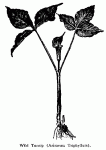 OTHER COMMON NAMES—Arum, three-leaved arum, Indian turnip, jack-in-the-pulpit, wake robin, wild pepper, dragon-turnip, brown dragon, devil's-ear, marsh-turnip, swamp-turnip, meadow-turnip, pepper-turnip, starch-wort, bog-onion, priest's-pintle and lords -and-ladies.
OTHER COMMON NAMES—Arum, three-leaved arum, Indian turnip, jack-in-the-pulpit, wake robin, wild pepper, dragon-turnip, brown dragon, devil's-ear, marsh-turnip, swamp-turnip, meadow-turnip, pepper-turnip, starch-wort, bog-onion, priest's-pintle and lords -and-ladies.
HABITAT AND RANGE—Wild Turnip inhabits moist woods from Canada to Florida and westward to Kansas and Minnesota.
DESCRIPTION OF PLANT—Early in April the quaint green and brownish purple hooded flowers of the wild turnip may be seen in the shady depths of the woods.
It is a perennial plant belonging to the arum family (Araceae), and reaches a height of from 10 inches to 3 feet. The leaves, of which there are only one or two, unfold with the flowers; they are borne on long, erect, sheathing stalks, and consist of three smooth, oval leaflets, the latter are 3 to 6 inches long, and from 1 ½ to 3 ½ inches wide, net veined, and with one vein running parallel with the margins. The "flower" is curiously formed, somewhat like the calla lily, consisting of what is known botanically as a spathe, within which is inclosed the spadix. The spathe is an oval, leaflike part, the lower portion of which, in the flower under consideration, is rolled together so as to form a tube, while the upper, pointed part is usually bent forward, thus forming a flap or hood over the tube shaped part which contains the spadix. In fact it is very similar to the familiar flower of the calla lily of the gardens, except that, instead of being white, the wild turnip is either all green or striped with very dark purple, sometimes seeming almost black, and in the calla lily the "flap" is turned back, whereas in the wild turnip it is bent forward over the tube. Inside of the spathe is the spadix, also green or purple, which is club shaped, rounded at the summit, and narrowly contracted at the base, where it is surrounded by either the male or female flowers or both, in the latter case (the most infrequent) the male flowers being placed below the female flowers. In autumn the fruit ripens in the form of a bunch of bright scarlet, shining berries. The entire plant is acrid, but the root more especially so.
DESCRIPTION OF THE ROOT—The underground portion of this plant is known botanically as a "corm," and is somewhat globular and shaped like a turnip. The lower part of the corm is flat and wrinkled, while the upper part is surrounded by coarse, wavy rootlets. The outside is brownish gray and the inside white and mealy. It has no odor, but an intensely, acrid, burning taste, and to those who may have been induced in their school days to taste of this root wild turnip will be familiar chiefly on account of its never-to-be-forgotten acrid, indeed, caustic, properties. The dried article of commerce consists of round, white slices, with brown edges, only slightly shrunken, and breaking with a starchy fracture.
COLLECTION, PRICES AND USES—The partially dried corm is used in medicine. It is dug in summer, transversely sliced, and dried. When first dug it is intensely acrid, but drying and heat diminish the acridity. It loses its acridity rapidly with age. Wild Turnip brings from 7 to 10 cents a pound.
The corm of Wild turnip, which was official in the United States Pharmacopoeia from 1820 to 1870, is used as a stimulant, diaphoretic, expectorant, and irritant.
Ginseng and Other Medicinal Plants, 1936, was written by A. R. Harding.

